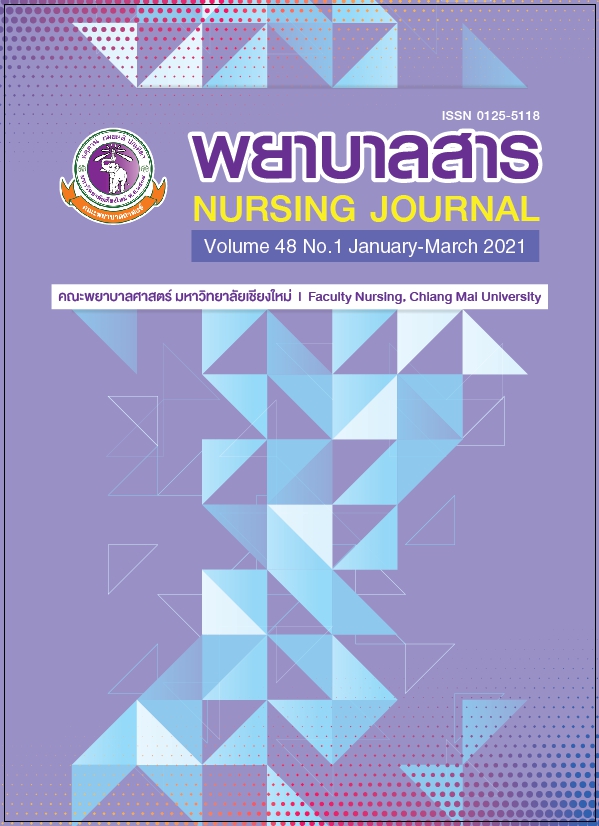Developing Care System Network for Stroke Patients in Chiang Mai Province
Keywords:
Care System for Stroke Patients, Stroke networkAbstract
ผู้ที่มีอาการของโรคหลอดเลือดสมองมักมีความพิการหลงเหลือส่งผลกระทบต่อคุณภาพชีวิต การวิจัยครั้งนี้เป็นการวิจัยและพัฒนา (Research and Development: R&D) มีวัตถุประสงค์เพื่อพัฒนาระบบการดูแลผู้ป่วยโรคหลอดเลือดสมอง ภายใต้บริบทของเครือข่ายจังหวัดเชียงใหม่ โดยดำเนินการวิจัยเป็น 4 ระยะได้แก่ 1) วิเคราะห์สถานการณ์ 2) พัฒนาโปรแกรม 3) นำไปใช้ 4) ประเมินผล กลุ่มตัวอย่างเลือกแบบเจาะจงเป็นทีมสหสาขาวิชาชีพของเครือข่ายโรคหัวใจจังหวัดเชียงใหม่ จำนวน 30 คน พยาบาลวิชาชีพและพยาบาลผู้จัดการรายกรณีโรงพยาบาลนครพิงค์ จำนวน 105 คน และผู้ป่วยโรคหลอดเลือดสมองที่เข้ารับการรักษาในโรงพยาบาลนครพิงค์ โดยแบ่งเป็น 2 กลุ่ม กลุ่มควบคุม เก็บข้อมูลระหว่าง เดือนมิถุนายน ถึงเดือน สิงหาคม 2563 จำนวน ผู้ป่วย 912 คน และกลุ่มศึกษาคือกลุ่มที่ใช้ระบบการดูแลผู้ป่วยผู้ป่วยโรคหลอดเลือดสมองแบบครบวงจรระหว่างเดือน ตุลาคม ถึงเดือนธันวาคม 2563 จำนวน 815 คน เก็บรวบรวมข้อมูลด้วยการสัมภาษณ์เชิงลึก การสนทนากลุ่ม การสังเกตแบบมีส่วนร่วม และการศึกษาเอกสาร ข้อมูลเชิงปริมาณวิเคราะห์ข้อมูลด้วยสถิติเชิงพรรณนา และเชิงอนุมาน paired t-test, Independent t- test และ exact probability ข้อมูลเชิงคุณภาพโดยการวิเคราะห์เนื้อหา
ผลการวิจัยพบว่า เกิดระบบการดูแลผู้ป่วยโรคหลอดเลือดสมองที่มีมาตรฐานการดูแล ประกอบด้วย 3 ระยะ 1) ระยะก่อนมาโรงพยาบาล (pre-hospital) เริ่มตั้งแต่กระบวนการคัดกรองผู้ป่วยการส่งต่อผู้ป่วยเข้ารับการดูแลในโรงพยาบาล 2)ระยะการรักษาพยาบาลในโรงพยาบาล (in hospital) การดูแลรักษาโดยทีมสหวิชาชีพในโรงพยาบาล การใช้พยาบาลผู้จัดการรายกรณีในการบริหารจัดการการดูแลในระยะเปลี่ยนผ่าน การพัฒนาทักษะการดูแลผู้ป่วยและผู้ดูแลหลัก 3) ระยะการดูแลต่อเนื่องในชุมชน (post hospital) การส่งต่อผู้ป่วยสู่การดูแลโดยชุมชน ทีมสหวิชาชีพ เข้าร่วมกับหน่วยงานในชุมชนติดตามเยี่ยม เพื่อให้ความช่วยเหลือตามปัญหาและความต้องการแต่ละบุคคล โดยมีองค์ประกอบหลัก คือ STROKE CARE และก่อให้เกิดผลลัพธ์ภาพรวมด้านการรักษาพยาบาล คือ อัตราการได้รับยาละลายลิ่มเลือดทางหลอดเลือดดำ (rt-PA) ภายใน 60 นาที มีอัตราเพิ่มขึ้นจากร้อยละ 81.25 เป็นร้อยละ85.00 อัตราผู้ป่วยเข้ารับการรักษาได้ตามมาตรฐานเวลา ภายใน 180 นาที เพิ่มขึ้นจากร้อยละ 54.19 เป็น 59.92 อัตราการเกิดภาวะปอดอักเสบ ลดลงจากร้อยล 6.90 เหลือร้อยละ 3.19 อัตราการการติดเชื้อในระบบทางเดินปัสสาวะ ลดลงจาก 7.01 เหลือ 4.75 อัตราการเกิดแผลกดทับลดลงจาก1.20 เหลือ 0.98 จำนวนวันนอนโรงพยาบาล ลดลงจาก 7 วันเหลือ 5 วัน ค่าใช้จ่ายในการรักษาพยาบาลเฉลี่ยลดลงจาก 25,230 บาท เหลือ 18,445 บาท อัตราการกลับมารักษาซ้ำภายใน 28 วันลดลงจากร้อยละ 8.55 เหลือ 4.09 อย่างมีนัยสำคัญทางสถิติ .05 ส่วนข้อมูลส่วนบุคคลด้านความสามารถในการปฏิบัติกิจวัตรประจำวัน เพิ่มจากร้อยละ 62.25 เป็น 72.10 คุณภาพชีวิตของผู้ป่วยค่าคะแนนเฉลี่ยเพิ่มจาก 2.62 เป็น 3.60 และความพึงพอใจของผู้ป่วยและญาติเพิ่มขึ้น อย่างมีนัยสำคัญทางสถิติ .05
สรุปได้ว่าระบบการดูแลผู้ป่วยโรคหลอดเลือดสมองที่พัฒนาขึ้นสามารถเพิ่มคุณภาพการดูแลผู้ป่วย ได้อย่างมีประสิทธิภาพและเพิ่มคุณภาพชีวิตผู้ป่วยโรคหลอดเลือดสมองได้
References
Division of NCDs Department of Disease Control (2020). Annual Report 2019. Bangkok: Graphic and Design Printing House. (In Thai)
Institute of Neurology. (2010). Treatment of patients with cerebrovascular disease in the acute phase. Bangkok: Jichak Sale Printing. (In Thai)
Khamkhong, M. (2014). Stroke patient care: community hospital context. Journal of Mahidol University. Academic, 18(35), 133-143. (In Thai)
Krejcie RV, Morgan DW. (1970). Determining sample size for research activities. Educational and Psychological Measurement, 30, 607-10.
Kusuwan,C., & Hankunakul, W. (2009). Development of continuous care system in vascular patients brain in Nopparat Rajathanee Hospital. Journal of the Department of Medicine, 34(5), 376-382. (In Thai)
National Trustworthy and Competent Authority in Epidemiological Surveillance and Investigation.(2013). An investigation report on chronic non-chronic disease surveillance (2007-2009). Retrieved August 2020, from
http://203.157.15.4/ncd/chronic/chronic_52_10091170940.doc
Phanichkul, K. (2011). Factors correlated with quality of life of stroke patients. Saraburi. (In Thai)
Polchaiyo, S., Masaeng, A., Kardkaew, B. (2017). Development of a care system for stroke patients under the context Tertiary Hospital. Nakhon Phanom University Journal 25th anniversary academic session, 26-35. (In Thai)
Policy and Planning Information Center Nakorn Ping Hospital. (2019). Stroke patient statistics.Chiang Mai: Nakorn Ping Hospital. (In Thai)
Sangsonggrit, N., et al. (2014). Predictors of medication adherence in ischemic stroke patients. Nursing Journal, 41(2), 61-71. (In Thai)
Thangkrathok,P., Phosai,W,. PhiphatSombat, P. Trinaatthawan, P., & Suksathan,V. (2016).Correctness and accuracy of the stroke patient-specific quality of life survey version.Thai Journal of Health Sciences, 26(3), 3-43. (In Thai)
Veldeman M, Höllig A, Clusmann H, Stevanovic A, Rossaint R, Coburn M. (2016). Delayed cerebral ischaemia prevention and treatment after aneurysmal subarachnoid haemorrhage: A systematic review. British Journal of Anaesthesia, 117(1), 17-40.
Warlae, H. (2016) Factors affecting health quality of life of stroke patients. Yala Hospital,Yala Province. (Master of Science. Department of Public Health), Graduate School Yala, Rajabhat University. (In Thai)
Wongsa, D., Soivong, P, & Chaiard., J. (2018). Quality of life among stroke persons within six months post diagnosis. Nursing Journal, 45(2), 40- 50. (In Thai)
World Stroke Organization. (2020). What is stroke ?. Retrieved on19 Jan 2020 Retrieved from http://www.worldstrokecampaign.org/Facts/ Pages/WhatisStroke.aspx
Yamwong, C. (2008). Development of stroke patient care planning system using nurses: Case manager Sawanpracharak Hospital. Sawan Pracharak Vejsarn, 1(5),769- 779. (In Thai)
Downloads
Published
How to Cite
Issue
Section
License
บทความที่ได้รับการตีพิมพ์เป็นลิขสิทธิ์ของวารสารพยาบาลสาร
ข้อความที่ปรากฏในบทความแต่ละเรื่องในวารสารวิชาการเล่มนี้เป็นความคิดเห็นส่วนตัวของผู้เขียนแต่ละท่านไม่เกี่ยวข้องกับมหาวิทยาลัยเชียงใหม่ และคณาจารย์ท่านอื่นๆในมหาวิทยาลัยฯ แต่อย่างใด ความรับผิดชอบองค์ประกอบทั้งหมดของบทความแต่ละเรื่องเป็นของผู้เขียนแต่ละท่าน หากมีความผิดพลาดใด ๆ ผู้เขียนแต่ละท่านจะรับผิดชอบบทความของตนเองแต่ผู้เดียว






